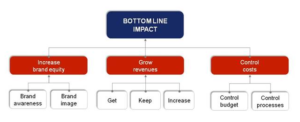Did you know you could boost your company’s bottom-line with a well-designed marketing strategy?
As a trusted marketing partner to companies of all sizes and from all sectors, 4P square has developed a 3-pillar model that increases brand equity, grows revenues, while at the same time, controlling the costs of your company. Read on to find out how our model can work for you.
A company’s bottom line consists of its net earnings, net profit, net income or earnings per share. Naturally, companies want this bottom line to be as high as possible and a good marketing strategy can have a considerable impact.
Our 4P square marketing strategy model is based on three pillars: increasing brand equity, growing revenues and controlling costs:

For every pillar, there are specific actions to be taken to ensure that the pillar is as robust as it needs to be, and brings the desired results.
Increase brand equity
To increase brand equity, the marketing team needs to focus on brand image and brand awareness. Before turning a customer into a loyal one, they must have first been aware that your brand existed. And for them to have known about your brand, your brand needs a strong brand image to stand out from your competitors and attract interest.
Once your marketing team has crafted a strong brand, awareness campaigns that highlight the brand’s Unique Selling Proposition(s) (USPs) can help attract leads who are a good fit for your product or service.
Consider which channels are most relevant for your target audience, and make sure that the values, tone, structure, design and content are consistent across all the channels where your customers might come into contact with your brand.
This kind of omnichannel approach will give a unified image and help build a more trusting relationship with your audience.
Grow revenues
To achieve an increase in revenue, your company first needs to get new customers. A great brand awareness and brand image, combined with creating true and trustworthy content from the offset will help you acquire new clients.
However, getting new clients is not enough; a company also needs to keep them. This starts with welcoming new clients, e.g. with a welcome mail.
Statistics suggest that welcome emails have a much higher open rate than standard emails, so opportunities like this should not be overlooked.
Client loyalty to a brand increases through continuous personalised contact that make the customer feel seen and understood. This contact includes emails, but also, for instance campaigns with specific reductions for loyal customers.
Alongside this, setting up programs to help prevent clients leaving is another important way to maintain a strong client base. For this, predictive models that notice behaviour associated with leaving or switching to another company can help you pre-empt a customer’s final decision, and approach them at the right time with the right message to convince them to change their minds.
Retaining clients requires never-ending attention, but it pays off. It typically costs five times as much to attract new customers than to keep existing ones.
So to maximise your marketing investment, efforts to keep your existing customers happy and turn them into loyal customers are well worth it.
Finally, companies don’t want to just get and keep clients, they want to increase the revenue that existing clients bring them.
Focusing on increasing the loyalty of the existing clients is a first important step, but companies should set up cross-selling and up-selling campaigns to increase the revenue generated per client.
Control costs
The last pillar of our model is controlling costs, and here we can break this down into two contributing parts: controlling the budget and controlling the processes.
The digital age, with its constant advances in technology opens up a huge range of possibilities not only in terms of marketing, but also in terms of cost reduction.
Firstly, customers can search quickly and with pinpoint accuracy for online information about a brand.
This potentially means that customers can find out a lot about your company without any specific marketing efforts. Secondly, predictive modelling techniques can be used to find out which customers are likely to switch brands.
This makes it possible to segment specifically on these customers, and create refined audiences for dedicated campaigns, rather than having to invest in all customers simultaneously.
The tracking of all manner of data and insights ensures that, with investments in the analyses and models, more personalised messages can be communicated to segmented customer groups. This means that by controlling the processes and tools, marketing teams can better control the budget they spend.
Conclusion
These three pillars (increasing brand equity, growing revenue and controlling costs) need to be in place and optimised if your marketing strategy is to have a measurable impact on your company’s bottom line.
But with the right approach, and by using the right tools at the right time, you can undoubtedly increase the net income of your company.
4P square created this model and has used it successfully with many of our clients.
For more about marketing and sales strategy, take a look at our marketing and sales strategy guide.


